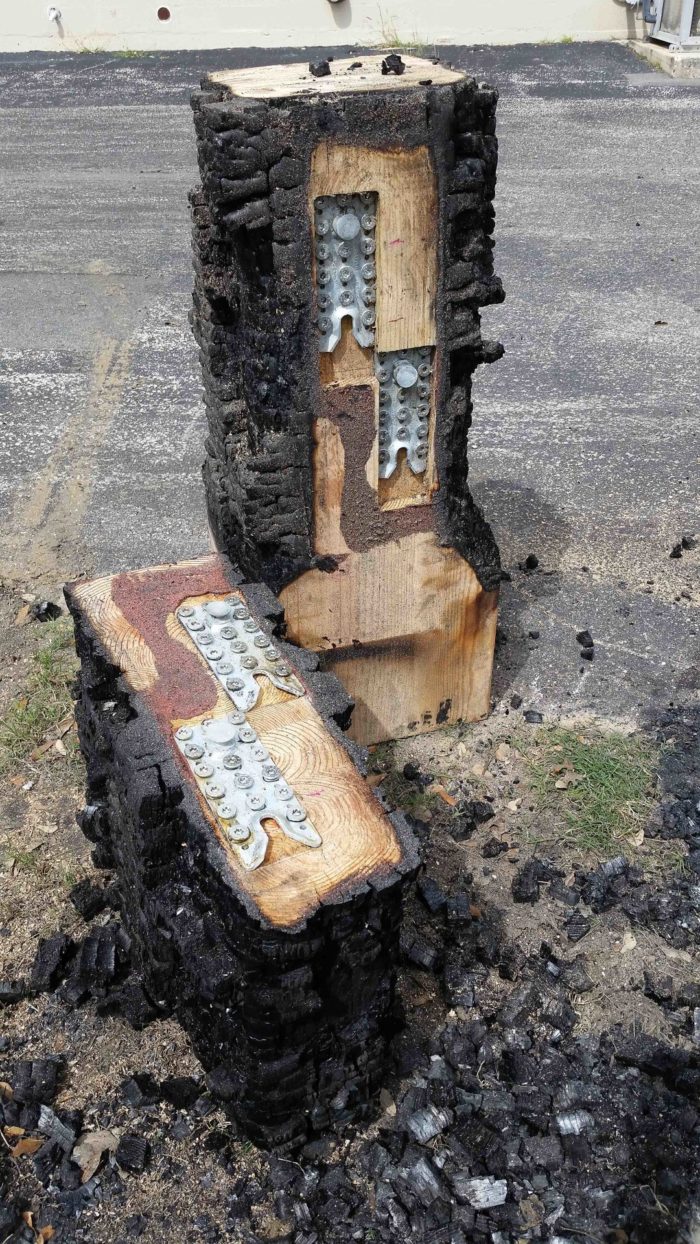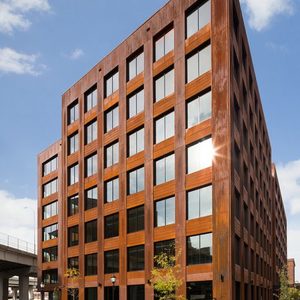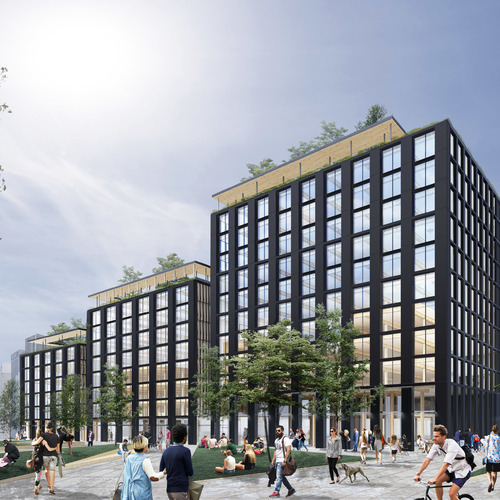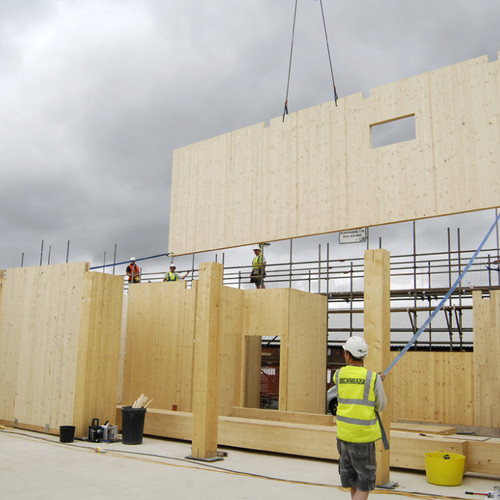Image Credit: reThink Wood
Image Credit: reThink Wood The tests were conducted in an upright furnace under load conditions replicating those of an actual building.
Full-scale fire tests on glulam beams and columns have given three off-the-shelf structural connectors a minimum one-hour fire rating, opening new opportunities for mass-timber construction in buildings below 85 feet high.
ReThink Wood, a group promoting the use of wood building components, said the lack of a fire resistance rating (FRR) for off-the-shelf connections has hindered the mass-timber industry, but test results will now allow designers to meet requirements of the International Building Code for so-called Type IV construction, and demonstrate that mass timber construction meets or exceeds fire safety standards in the U.S.
“Approval by an authority having jurisdiction will therefore be easier for future building projects,” authors of the report said.
David Barber, a fire safety engineer at Arup, one of the sponsors of the tests, said the findings should make mass timber a more viable option for a range of construction projects. Panel-to-panel connections in cross-laminated timber (CLT) buildings had already been tested and won code approval, but until now that was not the case for glulam connections in heavy timber buildings.
“This is very significant,” he said in an email. “Previous to these fire tests there were no glulam beam-to-column connectors available that had a 1-hour fire resistance rating, which is required by the International Building Code. So using glulam as part of a mass timber building was difficult as there was no easy way to achieve fire compliance for the beam to column connections.
“For the engineering community — and particularly those interested in expanding the possibilities of mass timber construction in the U.S. — these tests represent a significant step to ensure safety,” he said.
The tests, carried out at the Southwest Research Institute in San Antonio, Texas, were the result of a collaboration between a number of companies and trade groups that would like to see mass-timber construction grow: Arup, a design and engineering company with offices worldwide; D.R. Johnson, an Oregon-based manufacturer of CLT building components; MyTiCon, a manufacturer headquartered in British Columbia, Canada; and the Softwood Lumber Board, an industry trade group.
Connections tested under load
The tests were carried out to meet an ASTM standard (E119-16a) and satisfy Chapter 7 of the IBC, the report’s authors said.
Glulam beam-to-column connections were held in a frame that produced structural loads similar to those in an actual building. The mockup was housed in an upright furnace. Glulam timbers, made from typical commodity stock, were capped with a floor made from cross-laminated timber. A jack applied a load directly to the floor over the beam-end connections.
Researchers used three types of connectors, two Ricon S steel connectors and a Knapp Megant aluminum connector. Connections were protected by a bead of sealant applied on the face of the column before the beam was attached.
According to the report, beams varied in size — from 8 3/4 inches by 18 inches to 10 3/4 inches by 24 inches — and applied loads were as much as 16,620 lb. Fire resistance ratings were 1 hour on the smallest of the beams and 1.5 hour on the larger two beams.
Fire remains a concern with timber
Heavy timber construction is slowly gaining ground for commercial, residential, and institutional buildings, such as the seven-story T3 office building in Minneapolis or the 18-story student residence at the University of British Columbia. (Conventional stick framing is an overwhelming choice for multifamily projects in the U.S., accounting for as many as 87% of all projects, according to one estimate.)
Advocates see a lot to like with wood construction — a smaller carbon footprint than concrete and steel, high strength, faster construction schedules, and lower cost — but fire remains a concern. In Sandy Springs, Georgia, for example, the city council last year approved changes in the building code that prohibit the use of wood in multifamily projects any taller than three stories and larger than 100,000 square feet.
A lack of fire-tested approvals for products and assemblies has been a problem for the industry, Barber said in an email, which is not the case for other types of construction, like concrete.
“For example, if you want a floor system in a concrete building, there are numerous solutions, all of which have been fire tested and have the appropriate documentation and certification, so they can be used for construction,” Barber wrote. “For mass timber, the supply side is still getting up to speed and so the number of product approvals has been relatively slow, but there is real emphasis on getting the right fire testing in place and having the appropriate documentation to allow buildings to be constructed.”
Still unfamiliar to many officials
Another problem facing builders who want to work with mass timber is that many code officials are unfamiliar with the technology. Many of them have never seen a five- or six-story timber building made with glulam or CLT components.
“So there is hesitation, because it is new,” Barber said. “This is understandable and occurs with all new building technologies.” The reports, which are available from ReThink Wood, should give architects and engineers a way to satisfy code officials that the buildings they design will be safe.
The board of directors of the International Code Council named an ad hoc committee on tall wood structures in 2016, with the next opportunity for submitting a proposal on tall wood buildings coming next year, according to Fire Chief magazine. New code provisions would take effect in 2021.
Weekly Newsletter
Get building science and energy efficiency advice, plus special offers, in your inbox.
















One Comment
Fire Resistant Coatings
Why not coat the surface of the wood with Flamestop 2?
http://www.flamestop.com/cart/fire-retardant-spray-for-wood.html
It's great that the timber itself may achieve a certain fire rating but why not increase that level with a product that creates a self-extinguishing reaction when it comes into contact with an open flame?
Log in or create an account to post a comment.
Sign up Log in